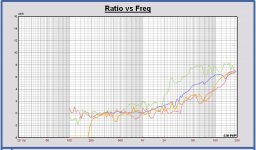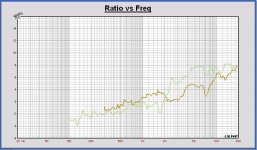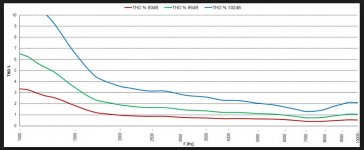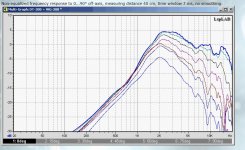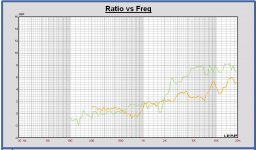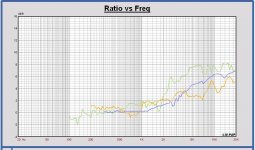I think that cost is a very important criteria to consider, it does not matter so much what type of solution we go for, it is more important to keep the end result attainable for the people of diyaudio.
+1 Kaffiman. That's my reason for being on the site. Generous donations from people such as Mr Pass make things attainable that otherwise wouldn't be. Same goes for speakers. Too expensive and they won't be built, but I think this design and budget sounds great and will out perform anything I could purchase in a shop for the same price
Though I am not likely to build a speaker of this size (though perhaps the Monkey Box), I would also suggest a dome if a suitable option can be found. Most of the well documented, high efficiency designs I see online tend to be compression driver based. There are not too many dome based options to choose from, so it would be great to have another design in the public domain. I would also agree that compression drivers on horns tend to sound different than domes, although mostly from the many subjective comments i've read online rather than direct experience.
I think that cost is a very important criteria to consider, it does not matter so much what type of solution we go for, it is more important to keep the end result attainable for the people of diyaudio.
Yes. But it would be awkward to not care about costs for the woofer and midrange, and then make tough compromises with the tweeter.
very useful feedbacks 🙂 thank you everybody.
by looking at the feedback i m guessing it is a 50/50 tie between CDs and domes.
I do not get in technicality since i do not have the knowledge, but If I may, I m not convinced that tweeters would give up in high efficiency home HIFI systems as mentioned before, this is a hifi speaker for home application with normal listening levels, not a PA system, also if we were looking for higher efficiency speakers CDs would make more sense but for a 90-92db speaker there are still good dome options available and no need to get a 100+db CD and pad it down. so at the end it all comes to how CDs sound vs domes, and I don't think one is much superior than the other one, it is just the matter of taste and both have pros and cons and can sound bad.
Beyma TPL-150 has been mentioned by John (from AE)as a good match for TD8M and I did mention it before but it will be close to 800$ for a pair and we would double the 1000$ limit for this project and that is something to keep in mind I guess.
my personal vote is the Morel tweeter, reasonable price, enough efficiency, and Morel has very good reputation in tweeters. but i m open to CD option as well if we decide to go that way.
that's just my two noobie cents.
thoughts :
we can have one candidate for each CD and tweeter and we can start a fund raiser to buy two options and test them to see which one fits better. we can modify the test cabinet to test both on same baffle, this will delay the process tho...
pcgab confirmed that he can help us with that if needed.
thank you pcgab for your generous contribution to this project 🙂
by looking at the feedback i m guessing it is a 50/50 tie between CDs and domes.
I do not get in technicality since i do not have the knowledge, but If I may, I m not convinced that tweeters would give up in high efficiency home HIFI systems as mentioned before, this is a hifi speaker for home application with normal listening levels, not a PA system, also if we were looking for higher efficiency speakers CDs would make more sense but for a 90-92db speaker there are still good dome options available and no need to get a 100+db CD and pad it down. so at the end it all comes to how CDs sound vs domes, and I don't think one is much superior than the other one, it is just the matter of taste and both have pros and cons and can sound bad.
Beyma TPL-150 has been mentioned by John (from AE)as a good match for TD8M and I did mention it before but it will be close to 800$ for a pair and we would double the 1000$ limit for this project and that is something to keep in mind I guess.
my personal vote is the Morel tweeter, reasonable price, enough efficiency, and Morel has very good reputation in tweeters. but i m open to CD option as well if we decide to go that way.
that's just my two noobie cents.
thoughts :
we can have one candidate for each CD and tweeter and we can start a fund raiser to buy two options and test them to see which one fits better. we can modify the test cabinet to test both on same baffle, this will delay the process tho...
pcgab confirmed that he can help us with that if needed.
thank you pcgab for your generous contribution to this project 🙂
Last edited:
Aatto, well it seems the Faital/regular PA brand build is cheaper by quite a bit. So it would probably be okay if one build just went "screw the budget!" And the other kept a more sane and sober approach. These speakers will be quite the performers at any rate, and it's nice to see a little bit of diversity. It is mostly the same project, just one version goes all-in and the other aims to achieve much the same performance on a smaller budget
I share the opinion of Aatto, this speaker is intended to become a hifi speaker. If you look to other powerful hifi speakers like ATC, Magico, B&W,… they all use dome tweeters.
As an information, in attach the DI in the horizontal plane on infinite baffle, calculated with off axis responses of the datasheet, of AE TD8M, Morel Cat378 (blue), Bliesma T34B-4 (red) and Satori TW29BN (yellow).
You can see the impact of the waveguide of the Morel.
With these drivers the DI can be kept flat up to about 3kHz.
With a CD horn tweeter the DI will be flat up to higher frequencies, but it can be expected that the DI of a CD horn tweeter will be higher. Look to the DI of a Monacor DT300 with waveguide WG300 (brown) together with the AE TD8M (green) in the other plot. The DI with the WG300 is higher than with the Morel waveguide. Maybe already too high for the best combi with the TD8M.
If somebody has some off axis measurements of CD tweeters, tweeters with waveguide, they are welcome to calculate the DI of them and compare with each other and with midranges.
I have no experience with CD tweeters, but looking to the horn size of most CD tweeters, it looks they are more directive than a classical cone midrange, more intended to be used in combination with a horn loaded midrange too. We have to calculate that.
In attach also the THD of the Morel Cat 378 at different voltage levels.
Edit: the DI calculations are draft. Sometimes the measurement conditons are not exactly known.
Placed in a little baffle for example, the DI already will be different.
Juhazi:
You mentioned a Bliesma T34 with waveguide. Do you know where to find more information about that?
As an information, in attach the DI in the horizontal plane on infinite baffle, calculated with off axis responses of the datasheet, of AE TD8M, Morel Cat378 (blue), Bliesma T34B-4 (red) and Satori TW29BN (yellow).
You can see the impact of the waveguide of the Morel.
With these drivers the DI can be kept flat up to about 3kHz.
With a CD horn tweeter the DI will be flat up to higher frequencies, but it can be expected that the DI of a CD horn tweeter will be higher. Look to the DI of a Monacor DT300 with waveguide WG300 (brown) together with the AE TD8M (green) in the other plot. The DI with the WG300 is higher than with the Morel waveguide. Maybe already too high for the best combi with the TD8M.
If somebody has some off axis measurements of CD tweeters, tweeters with waveguide, they are welcome to calculate the DI of them and compare with each other and with midranges.
I have no experience with CD tweeters, but looking to the horn size of most CD tweeters, it looks they are more directive than a classical cone midrange, more intended to be used in combination with a horn loaded midrange too. We have to calculate that.
In attach also the THD of the Morel Cat 378 at different voltage levels.
Edit: the DI calculations are draft. Sometimes the measurement conditons are not exactly known.
Placed in a little baffle for example, the DI already will be different.
Juhazi:
You mentioned a Bliesma T34 with waveguide. Do you know where to find more information about that?
Attachments
Last edited:
...a Bliesma T34 with waveguide. Do you know where to find more information about that?
Despite my limited experience with waveguides I'd expect the Bliesma is not the best choice for a waveguide. The dome diameter is rather large. Pathlength differences may therefore cause nasty dips and peaks in a waveguide at > 10 kHz or so. Why would you want to put the Bliesma in a waveguide anyway?
I think that with a waveguide like the Monacor WG300, there is a wider range of equal DI of tweeter and midrange between 1 and 2kHz.
I had better not posted that plot of the Monacor WG300. There is a bump between 1 and 2 kHz and I think it is caused by a too small measurement baffle, a kind of bafflestep what you see there.
So my expectation is that with a correct measurement of a tweeter with such waveguide the DI will be the same for tweeter and midrange between 1 and 2 kHz.
We need are own measurements !!
I agree that placing a waveguide is critical. Indeed some resonances can be seen above 10kHz sometimes.
But I totally have any practical experience using waveguides myself.
Edit:
The baffle size of the DT300-WG300 measurement was 24 x 35 cm. So, forget the DI calculation of the WG300 below 2kHz in my earlier post.
I found that measurement here: www.audioexcite.com >> Monacor DT-300 + WG-300.
I had better not posted that plot of the Monacor WG300. There is a bump between 1 and 2 kHz and I think it is caused by a too small measurement baffle, a kind of bafflestep what you see there.
So my expectation is that with a correct measurement of a tweeter with such waveguide the DI will be the same for tweeter and midrange between 1 and 2 kHz.
We need are own measurements !!
I agree that placing a waveguide is critical. Indeed some resonances can be seen above 10kHz sometimes.
But I totally have any practical experience using waveguides myself.
Edit:
The baffle size of the DT300-WG300 measurement was 24 x 35 cm. So, forget the DI calculation of the WG300 below 2kHz in my earlier post.
I found that measurement here: www.audioexcite.com >> Monacor DT-300 + WG-300.
Last edited:
^That's as good as it can be! Reasonable price and available everywhere.
Ideally, waveguide or horn should have at least same diameter as the mid it is paired with. Now loading stops below 2kHz , which might be good or bad for xo slope.


Ideally, waveguide or horn should have at least same diameter as the mid it is paired with. Now loading stops below 2kHz , which might be good or bad for xo slope.


DT-300 + WG300 seems like a very good solution.
This combination have also been evaluated by Mr. Gravesen. He also suggests removing the ferrofluid and adding a felt ring.
This combination have also been evaluated by Mr. Gravesen. He also suggests removing the ferrofluid and adding a felt ring.
I did find better measurements of the Monacor DT300 with WG300 waveguide on this site:
Wave guides & horns.
Now I have better results for the DT300-WG300 DI also.
The off axis measurements of the Audioexite website are different below 2 kHz, probably affected by the small measurement baffle, in a way there is a mix of waveguide and baffle impact.
To compare in the best way with the AE TD8M I have calculated the DI with the 15, 30 and 45 degrees off axis responses also for the DT300-WG300. I have no more data of the AE TD8M.
Looking to the comparing results, the DI is more matching now for AE TD8M (green) and the DT300-WG300 (yellow).
To compare also with the Morel Cat378, I have added the DI in a second plot in blue color.
Remark that I only used the 30 and 45 degrees off axis SPL for the Morel calculation, I don’t have more information. It has some impact on the DI absolute level.
The Monacor DT300 cannot be used, it has too low sensitivity above 10 kHz.
Juhazi, I agree, we have to find a waveguide with about the same dimensions as the midrange for the best results.
On the Kimmo Saunisto website, there are also other waveguide measurements, very interesting stuff. I shall calculate also the DI of some other waveguides with larger horn, to compare DI values, and see how they match with an 8 inch midrange.
As a first conclusion the Morel can be used IMO, but let’s look first to tweeters with a larger waveguide some like the Monacor WG300.
Wave guides & horns.
Now I have better results for the DT300-WG300 DI also.
The off axis measurements of the Audioexite website are different below 2 kHz, probably affected by the small measurement baffle, in a way there is a mix of waveguide and baffle impact.
To compare in the best way with the AE TD8M I have calculated the DI with the 15, 30 and 45 degrees off axis responses also for the DT300-WG300. I have no more data of the AE TD8M.
Looking to the comparing results, the DI is more matching now for AE TD8M (green) and the DT300-WG300 (yellow).
To compare also with the Morel Cat378, I have added the DI in a second plot in blue color.
Remark that I only used the 30 and 45 degrees off axis SPL for the Morel calculation, I don’t have more information. It has some impact on the DI absolute level.
The Monacor DT300 cannot be used, it has too low sensitivity above 10 kHz.
Juhazi, I agree, we have to find a waveguide with about the same dimensions as the midrange for the best results.
On the Kimmo Saunisto website, there are also other waveguide measurements, very interesting stuff. I shall calculate also the DI of some other waveguides with larger horn, to compare DI values, and see how they match with an 8 inch midrange.
As a first conclusion the Morel can be used IMO, but let’s look first to tweeters with a larger waveguide some like the Monacor WG300.
Attachments
Last edited:
I agree, we have to find a waveguide with about the same dimensions as the midrange for the best results.
I am not sure about this. Anyway, I'd suggest to head over to this thread. These guys know much more about waveguides. I am in the process of checking out a Scan R2904 in a waveguide for the Monkey Coffin with their help.
Ok Matthias, of course we have to take maximally the benefits of the experience in that thread and of other information that can be found. But in parallel it is not bad to check some things ourselves. Otherwise we better stop designing and let it do by others 🙂.
Designing a waveguide myself and implement it, it is not my ambition. Just checking existing waveguides with correct off axis measurements, we can do ourselves IMO.
Anyway, I did some further study and looked to my AE TD8M Leap model and I did found that it matches very well with the AE off axis measurements.
In the plot the normalized off axis responses of the AE measurement (colors) versus the Leap model (grey) .
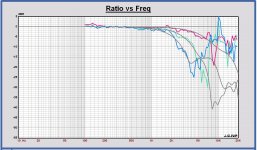
Also the DI in a horizontal plane +/- 45 degrees with the Leap model (grey) and the AE measurement (green) fits well.
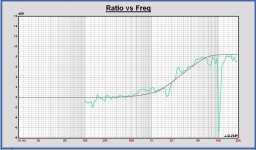
So for the first speaker simulations the AE TD8M Leap model can be used.
I compared now the DI of the Monacor DT300-WG300 (red) with the AE TD8M Leap model (grey) in a +/- 90 degrees horizontal plane also, using the Kimmo Saunisto measurements.
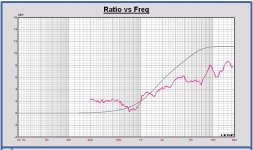
You can see that the TD8M already becomes more directive above 1.5kHz. With a X-over crossing around 1800 Hz, some rather good result can be obtained with such Monacor WG300 alike waveguide.
Matthias:
I agree that a waveguide with the same dimensions as the midrange probably is not the good criterion for a waveguide design.
Remark that these are DI values on infinite baffle and not in the enclosure. The cabinet will change the mean DI value below about 1.5 kHz, but expected to be the same change for both drivers.
Also these results are based on measurements, without knowing the exact measurement conditions. We have to measure ourselves also later on, at least in the cabinet.
Designing a waveguide myself and implement it, it is not my ambition. Just checking existing waveguides with correct off axis measurements, we can do ourselves IMO.
Anyway, I did some further study and looked to my AE TD8M Leap model and I did found that it matches very well with the AE off axis measurements.
In the plot the normalized off axis responses of the AE measurement (colors) versus the Leap model (grey) .

Also the DI in a horizontal plane +/- 45 degrees with the Leap model (grey) and the AE measurement (green) fits well.

So for the first speaker simulations the AE TD8M Leap model can be used.
I compared now the DI of the Monacor DT300-WG300 (red) with the AE TD8M Leap model (grey) in a +/- 90 degrees horizontal plane also, using the Kimmo Saunisto measurements.

You can see that the TD8M already becomes more directive above 1.5kHz. With a X-over crossing around 1800 Hz, some rather good result can be obtained with such Monacor WG300 alike waveguide.
Matthias:
I agree that a waveguide with the same dimensions as the midrange probably is not the good criterion for a waveguide design.
Remark that these are DI values on infinite baffle and not in the enclosure. The cabinet will change the mean DI value below about 1.5 kHz, but expected to be the same change for both drivers.
Also these results are based on measurements, without knowing the exact measurement conditions. We have to measure ourselves also later on, at least in the cabinet.
I agree that a waveguide with the same dimensions as the midrange probably is not the good criterion for a waveguide design.
FWIW, I agree with this as well. I would be a bit worried about center to center spacing of an ~203mm mid driver and ~203mm waveguide.
Remark that these are DI values on infinite baffle and not in the enclosure. The cabinet will change the mean DI value below about 1.5 kHz, but expected to be the same change for both drivers.
Also these results are based on measurements, without knowing the exact measurement conditions. We have to measure ourselves also later on, at least in the cabinet.
Based on your simulations and some quick reading around the 'net, the Monacor 300-300 combination looks quite nice. The price is great, certainly.
Paul is it possible for you to calculate/determine what 'setback' the drivers would need to be time aligned? Making stepped baffles isn't too difficult.
Not sure if time alignment is one of the goals of the project.?
Cheers,
Gable
Hi Gable,
Concerning the Monacor 300-300 choice, I have some doubts about the SPL level above 10kHz, which is maybe too low. You can also see in these tests:
Test Monacor DT-300 at the Waveguide WG-300 - Heissmann Acoustics
www.audioexcite.com >> Monacor DT-300 + WG-300
Also the dip at 6.5 kHz, even without the waveguide looks not so good.
The Monacor waveguide, as an example, places the front of the tweeter 32 mm backwards.
I did some acoustical center measurements in the past. For an 8 inch, it is about 30 - 35 mm.
So maybe a waveguide will compensate rather good for the acoustical center offset of the woofer.
We have to measure it later on. I do it by measuring the time difference of the impulse start of an mls measurement for all drivers, placed on exact the same position on an IEC baffle at 1m on axis exactly for all drivers.
Concerning the Monacor 300-300 choice, I have some doubts about the SPL level above 10kHz, which is maybe too low. You can also see in these tests:
Test Monacor DT-300 at the Waveguide WG-300 - Heissmann Acoustics
www.audioexcite.com >> Monacor DT-300 + WG-300
Also the dip at 6.5 kHz, even without the waveguide looks not so good.
The Monacor waveguide, as an example, places the front of the tweeter 32 mm backwards.
I did some acoustical center measurements in the past. For an 8 inch, it is about 30 - 35 mm.
So maybe a waveguide will compensate rather good for the acoustical center offset of the woofer.
We have to measure it later on. I do it by measuring the time difference of the impulse start of an mls measurement for all drivers, placed on exact the same position on an IEC baffle at 1m on axis exactly for all drivers.
I heard such kind of tweeter in the Magico mini about 5 years ago.I am in the process of checking out a Scan R2904 in a waveguide for the Monkey Coffin with their help.
Magico Loudspeakers | Mini
That was really not good. Ok on axis, but if you listened a little off axis, a real disaster, very directive for high frequencies.
At that time they said, it was a Scanspeak type, made for Magico.
Just an an information, maybe the R2904 is completely different.
Very good points, I had not looked at that other data as yet. I will look at those links more in depth.
I suspected the time alignment with the waveguide would be very close. It sounds like we can test the offset/setback of all the drivers pretty easily, so that's encouraging.
I plan to make an IEC baffle, and test jig once Aato get's the drivers delivered.
Do you have any information on the standard IEC baffle size, and driver 'plate' placement?
I've seen a few different references online, but not sure which is ideal, or correct.
Cheers,
Gable
I suspected the time alignment with the waveguide would be very close. It sounds like we can test the offset/setback of all the drivers pretty easily, so that's encouraging.
I plan to make an IEC baffle, and test jig once Aato get's the drivers delivered.
Do you have any information on the standard IEC baffle size, and driver 'plate' placement?
I've seen a few different references online, but not sure which is ideal, or correct.
Cheers,
Gable
- Home
- Loudspeakers
- Multi-Way
- Open Source "Tower XL"
